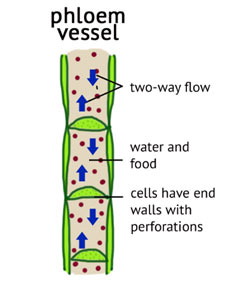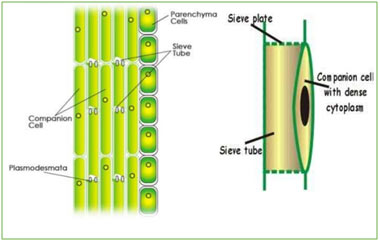Introduction
Phloems are living conducting tissues. They conduct prepared food from leaves to different parts of plants. Also, they are involved in the storage of food and provide mechanical support to plants.

Phloems are always associated with the xylem to form vascular bundles. According to their position, there are two phloems: Primary and Secondary Phloem.
Position of Phloem in Plants
Phloem is present external to the xylem in the axis. In some ferns and dicots, it is present inside the xylem. According to positions, there are:
- Abaxial Phloem: Present outside the xylem and also known as external phloem.
- Adaxial Phloem: Present inside the xylem and also known as internal phloem.
- Interxylary Phloem: In some plants, phloem strands or layers are included in the secondary xylem. It is called Interxylary phloem and is found in dicotyledons.
- Concentric Phloem: Interxylary phloem is in layers alternating with xylem layers.
- Foraminate Phloem: Phloem is present in strands surrounded by xylem tissues.
Components of Phloem
Phloem is composed of sieve elements, companion cells, phloem parenchyma, etc.
1. Sieve elements
The elongated cells with characteristic sieve areas in their walls are called sieve elements. These are formed by modifications in pits. The protoplasts are continuous in adjacent cells through the pores of sieve areas.

They are thin-walled and cytoplasmic connecting strands that are surrounded by callose. Walls are composed of two layers. The thin layer; close to the middle lamella and next to the cytoplasm is a thick layer.
The inner layer is called the nacreous layer. Sieve elements are of two types:
- Sieve cells:
These are not restricted to some specific part of the tissue. These have unspecialized areas. Sieve cells are long and slender with taper ends. They are longitudinally arranged overlapping each other.
- Sieve tube members:
These are well-developed areas and are only confined to the end of walls. They form sieve plates. These join end to end to form long sieve tubes.
2. Companion Cells
The thin-walled parenchyma cells closely associated with the sieve elements are called companion cells. These are cut off from the cells’ initial which later form sieve element. These are living cells.
They are rich in proteins. Albuminous cells are related to sieve cells are found in secondary phloem. These can be easily differentiated from parenchyma cells. Starch is absent in them. Respiratory and acid phosphatases activities occur in albuminous cells.
3. Sclerenchyma
These are commonly found in both primary and secondary phloem. And occupy the outer part in the primary phloem. These have thick secondary walls and may be living or dead. The phloem is called bast due to the presence of sclerenchymatous fibers.
4. Parenchyma
The parenchyma cells of the primary phloem are elongated and are arranged vertically. These cells become thick-walled in older portions of phloem and change into sclerenchyma cells. They are physiologically active and living cells.
They store different compounds like tannins, starch, crystals, etc.
Functions of Phloem
- Transportation of food.
- Conduction of organic and inorganic nutrients.
- Provide mechanical strength to plants.
- Has structural role.
- Pathway to many signaling molecules.
